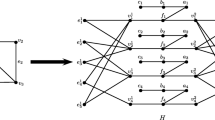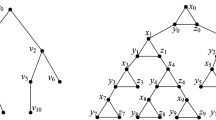Abstract
Let G be a graph with vertex set V and no isolated vertices, and let S be a dominating set of V. The set S is a semitotal dominating set of G if every vertex in S is within distance 2 of another vertex of S. And, S is a semipaired dominating set of G if S can be partitioned into 2-element subsets such that the vertices in each 2-set are at most distance two apart. The semitotal domination number \(\gamma _\mathrm{t2}(G)\) is the minimum cardinality of a semitotal dominating set of G, and the semipaired domination number \(\gamma _\mathrm{pr2}(G)\) is the minimum cardinality of a semipaired dominating set of G. For a graph without isolated vertices, the domination number \(\gamma (G)\), the total domination \(\gamma _t(G)\), and the paired domination number \(\gamma _\mathrm{pr}(G)\) are related to the semitotal and semipaired domination numbers by the following inequalities: \(\gamma (G) \le \gamma _\mathrm{t2}(G) \le \gamma _t(G) \le \gamma _\mathrm{pr}(G)\) and \(\gamma (G) \le \gamma _\mathrm{t2}(G) \le \gamma _\mathrm{pr2}(G) \le \gamma _\mathrm{pr}(G) \le 2\gamma (G)\). Given two graph parameters \(\mu \) and \(\psi \) related by a simple inequality \(\mu (G) \le \psi (G)\) for every graph G having no isolated vertices, a graph is \((\mu ,\psi )\)-perfect if every induced subgraph H with no isolated vertices satisfies \(\mu (H) = \psi (H)\). Alvarado et al. (Discrete Math 338:1424–1431, 2015) consider classes of \((\mu ,\psi )\)-perfect graphs, where \(\mu \) and \(\psi \) are domination parameters including \(\gamma \), \(\gamma _t\) and \(\gamma _\mathrm{pr}\). We study classes of perfect graphs for the possible combinations of parameters in the inequalities when \(\gamma _\mathrm{t2}\) and \(\gamma _\mathrm{pr2}\) are included in the mix. Our results are characterizations of several such classes in terms of their minimal forbidden induced subgraphs.

Similar content being viewed by others
References
Alvarado JD, Dantas S, Rautenbach D (2015) Perfectly relating the domination, total domination, and paired domination numbers of a graph. Discrete Math 338:1424–1431
Chudnovsky M (2006) Berge trigraphs. J Graph Theory 53:1–55
Chudnovsky M, Robertson N, Seymour PD, Thomas R (2006) The strong perfect graph theorem. Ann Math 164:51–229
Chvátal V (1976) On the strong perfect graph conjecture. J Combin Theory Ser B 20:139–141
Desormeaux WJ, Henning MA (2014) Paired domination in graphs: a survey and recent results. Util Math 94:101–166
Goddard W, Henning MA, McPillan CA (2014) Semitotal domination in graphs. Util Math 94:67–81
Haynes TW, Hedetniemi ST, Slater PJ (1998a) Fundamentals of domination in graphs. Marcel Dekker, Inc., New York
Haynes TW, Hedetniemi ST, Slater PJ (eds) (1998b) Domination in graphs: advanced topics. Marcel Dekker, Inc., New York
Haynes TW, Henning MA (2018) Semipaired domination in graphs. J Combin Math Combin Comput 104:93–109
Haynes TW, Slater PJ (1998) Paired domination in graphs. Networks 32(3):199–206
Henning MA (2017) Edge weighting functions on semitotal dominating sets. Graphs Combin 33:403–417
Henning MA, Marcon AJ (2014) On matching and semitotal domination in graphs. Discrete Math 324:13–18
Henning MA, Marcon AJ (2016a) Vertices contained in all or in no minimum semitotal dominating set of a tree. Discuss Math Graph Theory 36(1):71–93
Henning MA, Marcon AJ (2016b) Semitotal domination in claw-free cubic graphs. Ann Combin 20(4):799–813
Henning MA, Yeo A (2013) Total domination in graphs (springer monographs in mathematics) 2013. ISBN: 978-1-4614-6524-9 (Print) 978-1-4614-6525-6
Lovász L (1972) A characterization of perfect graphs. J Combin Theory Ser B 13:95–98
Zverovich IE, Zverovich VE (1995) An induced subgraph characterization of domination perfect graphs. J Graph Theory 20:375–395
Author information
Authors and Affiliations
Corresponding author
Additional information
T. W. Haynes: Research supported in part by the University of Johannesburg.
M. A. Henning: Research supported in part by the University of Johannesburg and the South African National Research Foundation.
Rights and permissions
About this article
Cite this article
Haynes, T.W., Henning, M.A. Perfect graphs involving semitotal and semipaired domination. J Comb Optim 36, 416–433 (2018). https://doi.org/10.1007/s10878-018-0303-9
Published:
Issue Date:
DOI: https://doi.org/10.1007/s10878-018-0303-9




